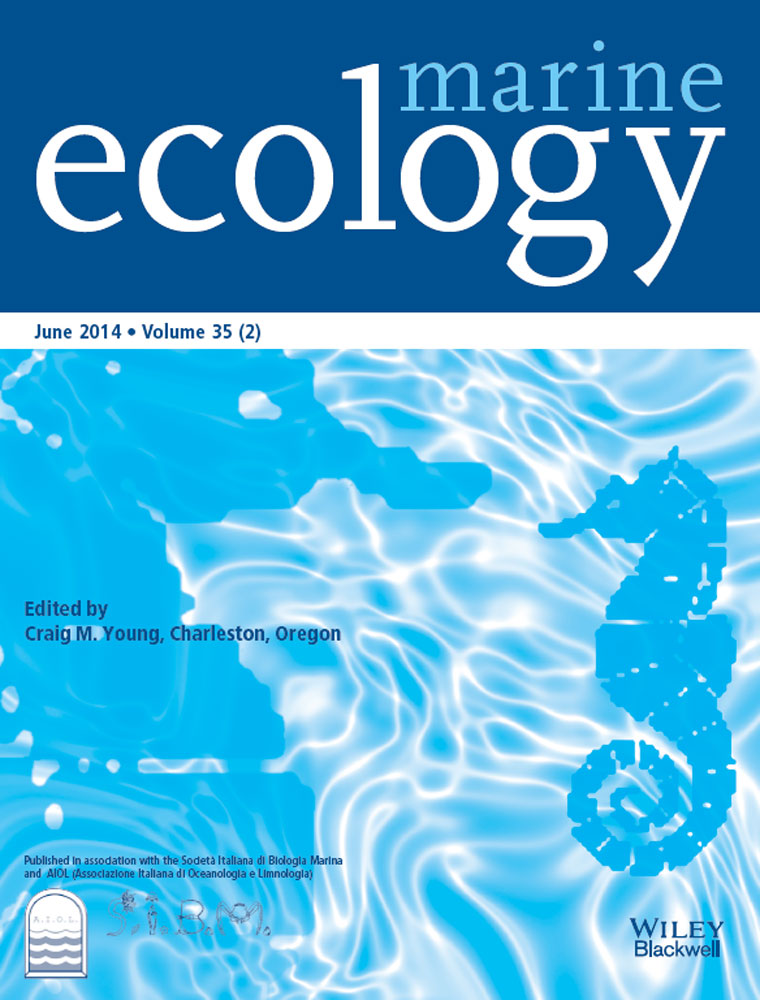Breeding cycle of the red squat lobster Pleuroncodes monodon H. Milne Edwards, 1837 (Decapoda, Muninidae) from deepwater Pacific of Costa Rica
Abstract
Reproduction and larval development of the red squat lobster Pleuroncodes monodon is strongly linked to temperature changes provoked by upwelling along the Chilean coast. Here, we propose the hypothesis that both the breeding cycle and the spatial distribution of egg-bearing females of P. monodon in Costa Rica are related to decreasing water temperatures during seasonal coastal upwelling. To describe the breeding cycle, squat lobsters were collected between February 2007 and January 2008 from the Central Pacific coast of Costa Rica. The presence of egg-bearing females in other areas of the Costa Rican coast was studied from samples collected during two latitudinal research cruises (August 2008: rainy season; May 2009: dry season). Our results revealed that P. monodon has a marked seasonal breeding period (from November to March), which is associated with decreasing water surface temperatures registered during coastal upwelling events. All females with embryos close to hatching were found in areas surrounding the Gulf of Nicoya, when upwelling events have been reported. The near absence of egg-bearing females in zones where upwelling does not occur suggests the existence of a strong correlation between upwelling events and the breeding cycle of P. monodon. Our information should be considered when developing management measures for the sustainable use of this potential fishery resource in the Pacific coast of Central America.
Introduction
The red squat lobster, Pleuroncodes monodon H. Milne Edwards, 1837 is an important fishery resource along the Pacific coast of South America (Bahamonde et al. 1986; Wehrtmann & Acuña 2011). The species' geographical distribution covers a wide latitudinal range (41° S-15° N; Haig 1955; Longhurst & Seibert 1971; Hendrickx & Harvey 1999), including scattered reports from Central America (Longhurst & Seibert 1971; Bianchi 1991; Wehrtmann et al. 2010) where this species can form abundant aggregations on the continental shelf (Bianchi 1991).
The results of several studies carried out along the Chilean coast have suggested that the red squat lobster reproduction and larval development are strongly linked to temperature changes associated with coastal upwelling. For instance, the number of egg-bearing females increases during colder months, when upwelling is more intense (Palma & Arana 1997) and larval development occurs mainly in areas of coastal upwelling (Palma 1994; Rivera & Santander 2005). However, our knowledge on the life cycle of P. monodon is limited to studies performed in temperate waters, which impedes any insights on reproductive patterns of red squat lobster in tropical waters. This is especially important in the Pacific coast of Costa Rica where P. monodon is abundant below 240 m of depth (Wehrtmann et al. 2010).
A prominent feature of the oceanography in the Costa Rican Pacific coast is the existence of a seasonal upwelling area located in the Gulf of Papagayo, close to the border with Nicaragua (e.g. Cronin et al. 2002; Fiedler 2002; Amador et al. 2006; Alfaro & Cortés 2012), and a transient upwelling event in the vicinity of the Gulf of Nicoya (Brenes et al. 2003). During these seasonal events (January to March), sea surface temperature can drop from about 27–29 °C to 20–22 °C (Glynn et al. 1983; Jiménez 2001), facilitating an increase in primary production (Pennington et al. 2006). Considering that the life history of P. monodon is influenced by upwelling events in South America, we propose the hypothesis that both the breeding cycle and spatial distribution of egg-bearing female red squat lobsters from the Pacific coast of Costa Rica are related to decreasing water temperatures associated with seasonal coastal upwelling. Information about the breeding cycle and spatial distribution of ovigerous females might facilitate the development of sustainable management strategies for this species along the Costa Rican coast, and provide valuable insights into the ecological adaptations of this squat lobster species along the Pacific coast of Central America.
Material and Methods
Squat lobster sampling
The breeding cycle of Pleuroncodes monodon was studied with monthly samples (collected between February 2007 and January 2008) captured mainly in the Central Pacific coast of Costa Rica (Fig. 1A); the presence of egg-bearing females in other areas of the Costa Rican coast was studied by examining the material collected during two latitudinal research cruises (August 2008: rainy season; May 2009: dry season) along the Pacific coast of Costa Rica (Fig. 1B).
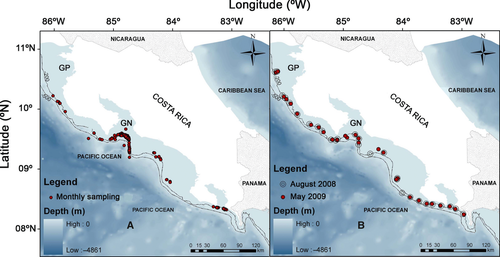
All samples were collected with commercial shrimp trawlers Onuva and Sultana, operated by The Rainbow Jewels S.A. The ships were specially conditioned for scientific research as part of a joint project undertaken with the University of Costa Rica since 2003. Both commercial shrimp trawlers (22.5 m in length, 270 hp) were equipped with two standard epibenthic nets (20.5 m long; mouth opening of 5.35 × 0.85 m; mesh size 4.5 cm; cod-end mesh size 3.0 cm). Sampling duration was 20 min at a speed of 2.0 knots (~3.7 km h−1); initial and final positions were recorded with a GPS, and fishing depth by an echo-sounder. Sampling depth varied between 146 and 347 m, covering the entire depth range previously reported for P. monodon in Costa Rica (Wehrtmann et al. 2010). Red squat lobsters were separated from the catch onboard, and samples (approximately 5 kg each) were stored in ice water and subsequently frozen until further analyses in the laboratory of the Unit for Fishery Research and Aquaculture (UNIP) of the Research Center for Marine Science and Limnology (CIMAR), University of Costa Rica, San José, Costa Rica.
In the laboratory, the collected specimens were sexed according to external male and female morphological descriptions by Bahamonde et al. (1986). Subsequently, the carapace length (CL; ±0.01 mm; from the posterior margin of the orbital arc to the posterior mid-dorsal region of the carapace) of each individual was measured. Ovigerous females were counted and separated to analyse the embryonic development of their egg mass. The development stage (DS) of the eggs carried by female of P. monodon was classified into three stages (Stage I–III) based on the shape and development of the abdomen and eyes of developing embryos (Wehrtmann 1990).
Monthly cruises
Monthly samples (between February 2007 and January 2008) of squat lobsters were mainly collected in the Central Pacific coast of Costa Rica (Fig. 1A) and were examined to describe the breeding cycle of Pleuroncodes monodon. During each monthly cruise, we recorded the bottom temperature (BT) and salinity (BS) using a CTD SBE25. Sea surface temperature (SST) was obtained from a monitoring program in the coastal upwelling area of the Gulf of Papagayo. Reproductive season was established by analysing the monthly presence of ovigerous females (OF) divided by the total number of females. The monthly occurrence of ovigerous females (expressed as percentage of all females collected during each month) was plotted and correlated (Spearman test, P < 0.05; Zar 1996) with the environmental information (BT, BS, SST) to test the possible relationship between the breeding cycle and environmental variability. The bathymetric distribution of egg-bearing females was determined by counting the number of individuals per depth.
Latitudinal cruises
The spatial distribution of Pleuroncodes monodon was estimated through an explicit geographic correlation between the data obtained from the sampling sites during two latitudinal research cruises (August 2008: rainy season; May 2009: dry season). Spatial variations in sex ratio were analysed by applying the chi-square test (χ2 = 1:1; P < 0.05) (Sokal & Rohlf 1995). The presence of egg-bearing females in other areas of the Costa Rican coast was studied by examining the material collected in these cruises.
Results
Breeding cycle
Bottom temperature and salinity presented a similar pattern during the study period (Fig. 2): both variables remained relatively stable and fluctuated between 11.4º and 13.2 °C and 34.6 and 34.9, respectively. The average values of the bottom temperature and salinity were slightly higher during the rainy season (12.6 °C and 34.9, respectively) than during the dry season (12.3 °C and 34.8, respectively). In the Gulf of Papagayo, the mean sea surface temperature (SST) was almost 2° lower between November and April (dry season: 26.2 °C; Fig. 2B) than from May to October (rainy season: 28.1 °C; Fig. 2B). The SST in the Gulf of Papagayo presented no significant correlation with bottom temperatures measured during the squat lobster sampling program (Spearman: Rs = 0.38, P > 0.05).
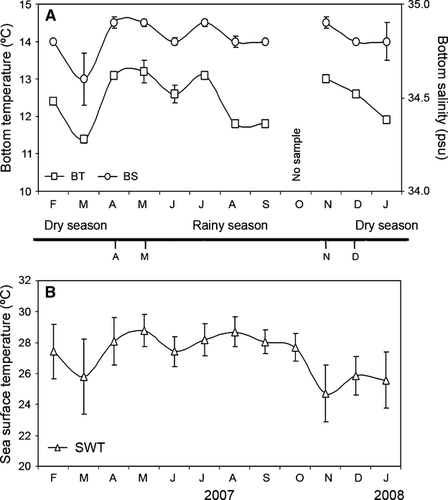
A total of 3455 squat lobsters were analysed (February 2007 to January 2008), 2367 (69%) males and 1088 (31%) females, of which 290 were ovigerous. Males measured 20.1–38.4 mm CL (29.7 ± 2.79 mm) and females 19.3–39.9 mm CL (27.5 ± 2.16 mm), respectively. The size of egg-bearing females ranged from 21.4 to 31.0 mm CL. Ovigerous females were caught from February to March 2007 and from November 2007 to January 2008 (Fig. 3). The presence of ovigerous females was not correlated with the bottom temperature and salinity (Spearman test, bottom temperature: Rs = −0.18, P > 0.05; bottom salinity: Rs = –0.29, P > 0.05) but it was significantly correlated with the monthly variation of SST in the Gulf of Papagayo (Spearman test, SST: Rs = −0.77, P < 0.05; Fig. 3). The monthly percentage of egg-bearing females coincided with the period of decreasing SST (December to April) during coastal upwelling events.
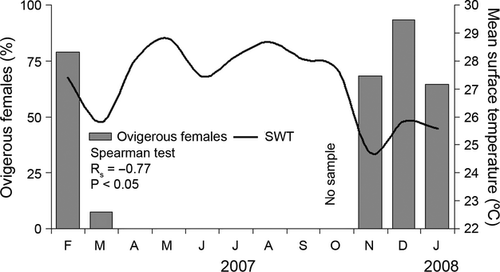
All ovigerous females were caught near the Gulf of Nicoya (central Pacific of Costa Rica, Fig. 4) in the 246–282 m depth range, with the exception of November. November was considered to be the start of the breeding season, as all egg-bearing females collected from this month to December (n = 179) carried recently-extruded embryos (Stage I). In January, all development stages were found to be attached to the captured ovigerous females (n = 66; Fig. 4), and from February to March (n = 45) all ovigerous females carried embryos close to hatching (Stage III) (Fig. 4).
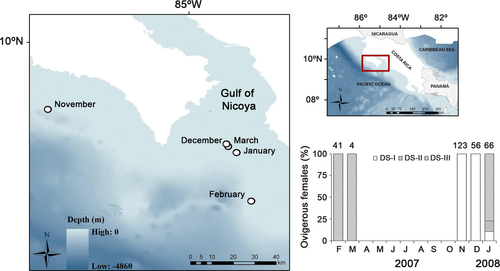
Latitudinal cruises
A total of 2667 squat lobsters were collected during the two latitudinal research cruises (August 2008 and May 2009). Pleuroncodes monodon was present in 53% of all hauls (n = 55), and the spatial aggregation pattern revealed a discontinuous distribution during both seasons (Fig. 5). During the rainy season (August 2008), the sex ratio remained balanced (1: 1) along the study area; during the dry season (May 2009), the locations with a balanced sex ratio were remitted to the southern area (Fig. 6). In both rainy and dry season, males predominated from the Central Pacific coast (9°15′N) to the northern part of the study area (Fig. 6). Only one ovigerous female carrying recently-extruded eggs (Stage I) was obtained during the two latitudinal cruises: this individual was collected during the August 2008 cruise in the vicinity of the Gulf of Nicoya.
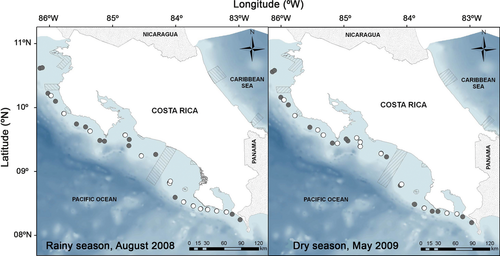
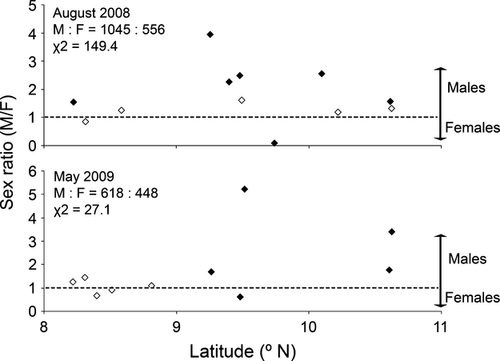
Discussion
The presence of egg-bearing females in the proximity of coastal upwelling events suggests that reproductive activities of Pleuroncodes monodon in the Pacific coast of Costa Rica are linked to physical (e.g. temperature) and ecological changes (e.g. phytoplankton bloom) caused by these upwelling events. Although Rivera & Santander (2005) have already speculated about the influence of upwelling events on the reproductive cycle of P. monodon from temperate waters, the current study demonstrates this association in a red squat lobster population from tropical waters. Our results confirm the tendency of P. monodon to reproduce during decreasing water temperatures (November to March), which has also been described for the Chilean population (Henríquez 1979; Bustos & Retamal 1985; Palma & Arana 1997). Figure 7 indicates different seasonal occurrence patterns displayed by ovigerous females in Chile and Costa Rica; in both cases the presence of egg-bearing females is associated with decreasing temperatures and local upwelling events (Glynn et al. 1983; Jiménez 2001; Thiel et al. 2007; Alfaro & Cortés 2012).

Our data regarding the presence of different embryonic stages suggest that egg production is strongly synchronized among females (Fig. 5). This also occurs in Pleuroncodes monodon from Chilean waters maintained under laboratory conditions (Thiel et al. 2012). The seasonal reproduction pattern observed in P. monodon females from Costa Rica seems to be associated with the seasonal coastal upwelling. Moreover, the absence of ovigerous females between April and September/October and the fact that all females in November and December carried newly-extruded eggs suggests a simultaneous selection of a favorable time for reproduction (e.g. low temperatures and available food), which may provide adequate environmental conditions for spawning and offspring survival. Both assumptions are consistent with the available information on the life history of P. monodon: this species reproduces mainly during upwelling events, when temperatures diminish below the annual mean (Henríquez 1979; Bustos & Retamal 1985; Palma & Arana 1997).
The embryonic period of P. monodon has been estimated using direct and indirect methods: under laboratory conditions the embryonic development lasted 31–49 days (Thiel et al. 2012), whereas field data suggested a duration of 90–120 days (Palma & Arana 1990). Our results seem to corroborate the latter assumption: the development of the embryos in Costa Rican waters lasted up to 4 months (November to February–March). These contradicting results between field and laboratory studies require further attention. The data presented by Thiel et al. (2012) revealed the potential number of broods on P. monodon obtained from Chilean waters. However, according to these authors the laboratory conditions may alter certain physiological processes due to an optimization of feeding conditions, which may enhance the capacity to produce successive broods in the laboratory. Therefore, the above-mentioned laboratory studies may indicate the potential of P. monodon to produce several annual broods during the seasonal reproductive period. Additional field sampling and laboratory experiments with females of P. monodon from Costa Rican waters are necessary to clarify the obvious uncertainties about the number of broods.
One consistent temporal–spatial pattern that has emerged from our research on the squat lobster population from the Pacific coast of Costa Rica is a fairly male-biased sex ratio. A similar trend was previously reported for other squat lobster populations from temperate waters, with 60% of the adult population composed of males (Palma & Arana 1997; Roa & Tapia 2000). According to the latter authors, predominance of males can be explained by a higher mortality of females due to fishing or predation. Considering that the P. monodon population in Costa Rica was not commercially exploited during the sampling period, it seems unlikely that fishery-related effects are responsible for the observed biased sex ratio. Assuming that both sexes have the same probability of being caught by predators, the predation hypothesis does not provide an adequate explanation for the observed differences. Other factors (spatial segregation, social structure, among others) probably contribute to the biased sex ratio observed in our study. The predominance of males in an area located between 9º and 11° N, the same area where all egg-bearing females were encountered, seems to indicate a sexual strategy of males to increase the probability of success during the mating (see Correa & Thiel 2003).
The spatial distribution of females and egg-bearing females suggests the existence of two migration processes in the Costa Rican population of P. monodon: (i) the migration of females during their ontogeny toward the upwelling areas and (ii) the displacement of egg-bearing females during incubation of embryos toward spawning areas (upwelling areas). The first proposition is supported by the near absence of egg-bearing females in the study area during a period without coastal upwelling. The second aspect may be explained by the spatial distribution of ovigerous females: at the beginning of the incubation period, ovigerous females were found in the south of the Gulf of Papagayo, whereas females with embryos close to hatching were collected exclusively in close proximity to the mouth of the Gulf of Nicoya. It is assumed that the association of these egg-bearing females with the entrance to the Gulf of Nicoya, one of the most productive estuaries on the world (Gocke et al. 2001; Cortés & Wehrtmann 2010), provides favorable conditions for the development and survival of larvae. Likewise, the presence of egg-bearing females with embryos close to hatching (n = 45) in a relatively small geographic area located in the vicinity of upwelling areas (Brenes et al. 2003) seems to suggest the existence of a common spawning area for P. monodon from Costa Rican waters.
Finally, our results concerning the identification of reproductive seasonality and spatial distribution patterns of egg-bearing females of P. monodon from Costa Rica are important life history features, which should be considered when developing sustainable management strategies for this potential resource along the Costa Rican coast (see Wehrtmann & Nielsen-Muñoz 2009; Wehrtmann & Acuña 2011).
Acknowledgements
We would like to express our gratitude to the company The Rainbow Jewels, S.A., Puntarenas, for all their support during the development of the present study. Likewise, thanks a lot to the captains (Rigo and Esteban) and the shrimp trawler crews Onuva and Sultana, all of whom collaborated with their valuable experience and knowledge during sample collection. We appreciate the logistic support provided by the CIMAR and the Escuela de Biología, Universidad de Costa Rica (UCR). We are grateful to the scientific personnel and students of the Unidad de Investigación Pesquera y Acuicultura (UNIP-CIMAR) for all their support during the course of this project. A special thanks goes to Jaime Nivia and Fresia Villalobos (UNIP-CIMAR) for their collaboration during the collection and handling of the squat lobster samples on board of the shrimp trawlers. We would also like to thank Tayler McLellan Clarke for proof-reading the manuscript and anonymous reviewers for their help improving the manuscript. Financial support was made available by the German company Ristic AG, Oberferrieden, the Costa Rican company The Rainbow Jewels S.A., Puntarenas, and the Universidad de Costa Rica (projects V.I. No. 111-A4-508, 808-A9-536 and 808-A9-537). Additional funding was provided by the ‘Program University – Enterprise for Sustainable Development’ (PUEDES) of the Council of Central American Universities (CSUCA), the German Society for Technical Cooperation (GTZ), and the University of Kassel, Germany. All sampling conducted in this study complied with current applicable state laws. The present study was completed by the first author to partially fulfil the requirements for a M.Sc. degree in Biology at the Escuela de Biología, Universidad de Costa Rica.



